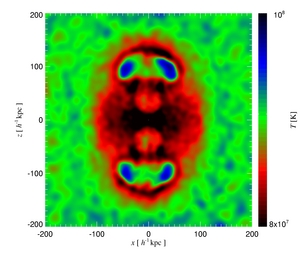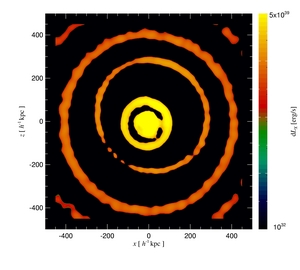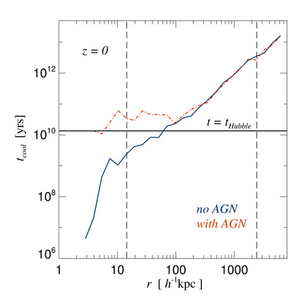|
|  |
Clusters of galaxies, the largest virialized objects in the
Universe, are an ideal laboratory for studying the physical processes
that shape the cosmic evolution of galaxies and their surrounding dark
matter halos. Recent observational progress has revealed a stunning
complexity of the gas dynamical processes in the intra-cluster medium
(ICM), including the discovery of phenomena which pose significant
challenges for theoretical modelling. Perhaps the most puzzling among
these observational facts is the so-called "cooling-flow" problem. Hot
intra-cluster gas emits diffuse X-ray radiation, making clusters of
galaxies extremely bright X-ray sources shining with up to a few times
1045 erg/s, an energy loss that should reduce the thermal
energy content of the gas. While the estimated cooling time in the
bulk of a cluster due to these radiative losses is typically longer
than the age of the Universe, this is not the case for the dense gas
in the cluster cores, where the cooling times are short due to the
sensitive dependence of the cooling rate on density. This implies
that the central gas should cool out of the cluster atmosphere,
leading to central mass deposition rates as high as 1200 solar masses
per year in some cases. However, the new generation of X-ray
telescopes, XMM-Newton and Chandra, failed to detect the predicted
huge amount of cold central gas, ruling out the simple cooling-flow
picture. Thus, a physical explanation for this apparent paradox needs
to be found.
Over the last couple of years, it has been recognized that probably
all galaxies with a spheroidal stellar component conceal a
supermassive black hole (BH) at their centers. This suggests the
existence of an important link between the growth of supermassive
black holes and the formation of their host galaxies, which presumably
originates in the energy released by an accreting BH and the impact
this has on the formation of the stellar spheroid. Similarly, when gas
is funneled towards the center of a cluster by cooling, a fraction of
the gas will be accreted by the BH, resulting in a substantial release
of energy. Provided the released energy can heat the central cluster
gas efficiently, the cooling losses may be offset. At the same time,
the feeding of the BH would be stopped, so we expect that this should
give rise to a periodic triggering of the AGN, establishing a
self-regulated activity pattern between cooling and AGN
activity. Direct support for the existence of energy input by AGN into
cluster cores comes from observations which show that AGN can inflate
hot, buoyant bubbles in the cluster atmospheres during their active
phases. The bubbles are thought to detach and rise from the cluster
center, and to interact with the surrounding gas, possibly providing
the needed heating mechanism.
In order to test whether this physical scenario of bubble heating
actually works, scientists from the Max-Planck-Institute for
Astrophysics have performed a series of hydrodynamical simulations in
which they incorporated periodic heating by AGN bubbles. For the first
time, they followed the formation and assembly of a set of galaxy
clusters in fully self-consistent cosmological simulations, analyzing in
particular how the properties of the intracluster medium and the cluster
galaxies change when AGN heating is included.
The simulations reproduce the characteristic features observed for the
bubble morphology, as can been seen in Figure 1, where we show a
temperature map of the cluster central region (see also the movie). The
bubbles develop a mushroom shaped structure when they rise in the
cluster atmosphere, pushing the intra-cluster gas above them and also
entraining some of the cooler central gas. As a result, they mix colder
and hotter gas components initially present at different radii, heating
up the central region of the cluster. However, this AGN heating
mechanism is comparatively gentle, generating no significant shock
waves, such that the gas on top of the bubbles forms cold rims, as
observed in a number of cases.
Moreover, after the thermal energy is released in a bubble, the
subsequent expansion generates sound waves that travel into the
ICM. These sound waves cause faint ripples in the X-ray emissivity (see
Figure 2) and can reach even the cluster outskirts within 109
yrs. Depending on the amount of viscosity of the gas, the bubble-induced
sound waves will dissipate their energy on different spatial scales,
possibly providing an additional mechanism for a non-local heating of the
cluster gas.
The use of fully self-consistent simulations of cluster formation
allowed the scientists from the Max-Planck-Institute for Astrophysics to
study how the AGN ``bubble-feedback'' influences the gaseous and stellar
properties over cosmic time. In particular, they analyzed the
cooling time of gas (illustrated in Figure 3), comparing the simulations
without (blue line) and with (red line) bubble heating. Clearly, the
gas residing in the cluster core is efficiently heated, showing much
higher values for the estimated cooling time. Along with the cooling
time, other thermodynamic properties of the intracluster gas change as
well, and the trends of these changes are all in the direction of
improving the match of the simulated systems with observations of real
galaxy clusters.
Interestingly, not only the state of the intra-cluster gas changes due
to the AGN activity, but also the properties of the central cluster
galaxy are altered. Most importantly, the number of stars forming in the
massive central cD galaxy is considerably reduced, up to the point of a
complete termination of star formation at late times. This is highly
relevant for another long standing problem of hydrodynamical simulations
of galaxy formation. They typically predicted the existence of too
massive and too blue central cluster galaxies compared with
observations. Bubble feedback, however, decreases the amount of stars
formed, and the heating of the inner regions together with the
accompanying reduction of the recent star formation rate makes the
central cluster galaxies redder, resulting in much better agreement with
observations.
It is a stunning revelation that objects as small as black holes can
affect the state of the largest virialized objects known in the
Universe, namely rich clusters of galaxies that often harbor more than a
thousand systems. Yet the outflows from accreting supermassive black
holes are so energetic that this is indeed possible, and as the results
in this work confirm, it might provide the right physical solution for
the "cooling-flow" paradox. Black holes thus appear as a crucial
component for understanding galaxy formation as a whole.
Debora Sijacki and Volker Springel
Original publication:
D. Sijacki and V. Springel: Hydrodynamical simulations of cluster
formation with central AGN heating, 2005, MNRAS, accepted
 astro-ph/0509506 astro-ph/0509506
Further information:
 Colliding galaxies light up dormant black holes Colliding galaxies light up dormant black holes
Tiziana Di Matteo, Volker Springel and Lars Hernquist
 Magnetic Turbulence in the Hearts of Clusters of Galaxies Magnetic Turbulence in the Hearts of Clusters of Galaxies
Torsten Ensslin and Corina Vogt
 The parallel lives of super-massive black holes and their host galaxies The parallel lives of super-massive black holes and their host galaxies
Andrea Merloni
 The Connection Between Active Galactic Nuclei and Starbursts
The Connection Between Active Galactic Nuclei and Starbursts
Guinevere Kauffmann
|




